We understand that you deserve the best-looking pets with that hint of unique. But it can be quite challenging to find the right one! However, we are here to help you with that. Today we will explore the most intriguing and unique fish with whiskers. These beautiful creatures are guaranteed to elevate your tank’s aesthetic.
Additionally, we will discuss the origin and appearance of these fish. We will also cover the functionalities and reasons behind these whisker-like extensions.
Let me ask: What do you think these whiskers are used for? Let’s uncover the mystery of these beautiful and mysterious fish in today’s article.
Weather Loach
The Weather Loach is native to the freshwater of East Asia. It thrives in slow-moving rivers, ponds, and rice paddies. Interestingly, this fish is very sensitive to atmospheric pressure. This means that changes in atmospheric pressure affect how this fish behaves. In countries like China and Japan, people traditionally observe this loach to predict the weather. Thanks to this sense of weather, it is well known as the living barometer.
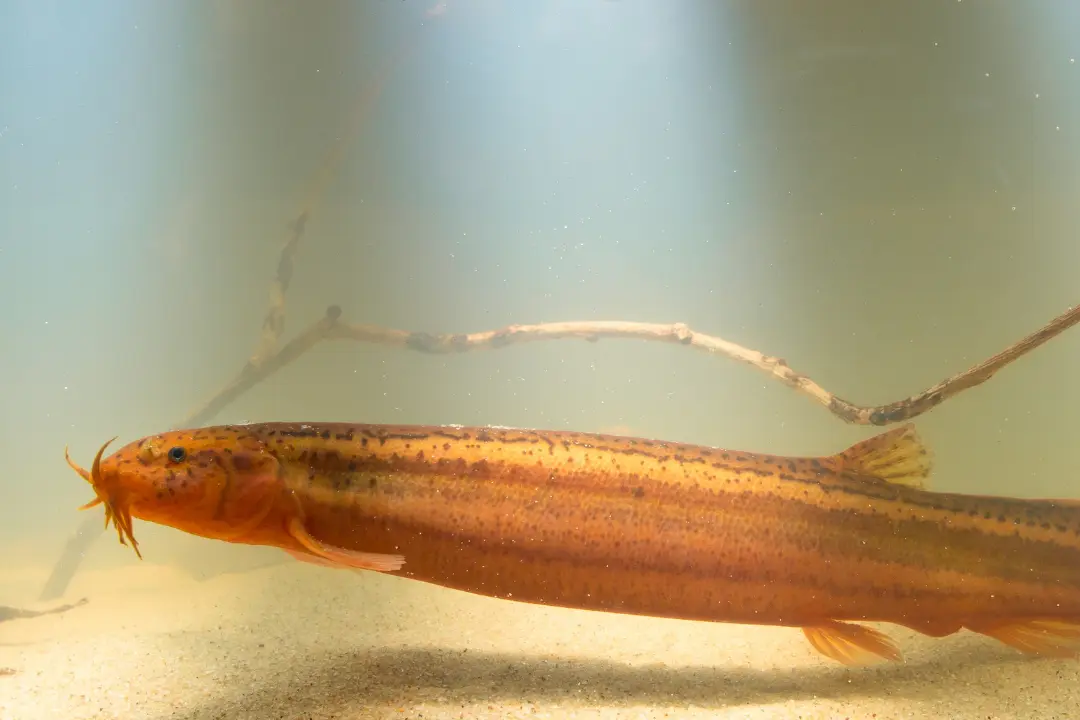
The Weather Loach has an elongated and slimy body, just like an eel. This long body can reach up to 12 inches in length. This fish has a blotchy color ranging from yellow to brown. Additionally, its body has spots or streaks that complete the look. This fish with whiskers has an exceptional body for camouflage.
Along with a murky body, this fish has small eyes and a downturned mouth like many bottom-dwelling fish.
Talking about the barbels, the weather loach has several pairs around its mouth. These are crucial for survival as they act as sensory organs used to detect food from the substrate. Additionally, these barbels can also taste the food. All in all, these barbels aid the fish to navigate and find food in low-light and murky waters.
Glass Catfish
The Glass Catfish inhabits the freshwater river basins of Thailand. This fish thrives in slow-moving rivers and streams with dense vegetation. Its natural habitat is very clean water and many shaded areas.
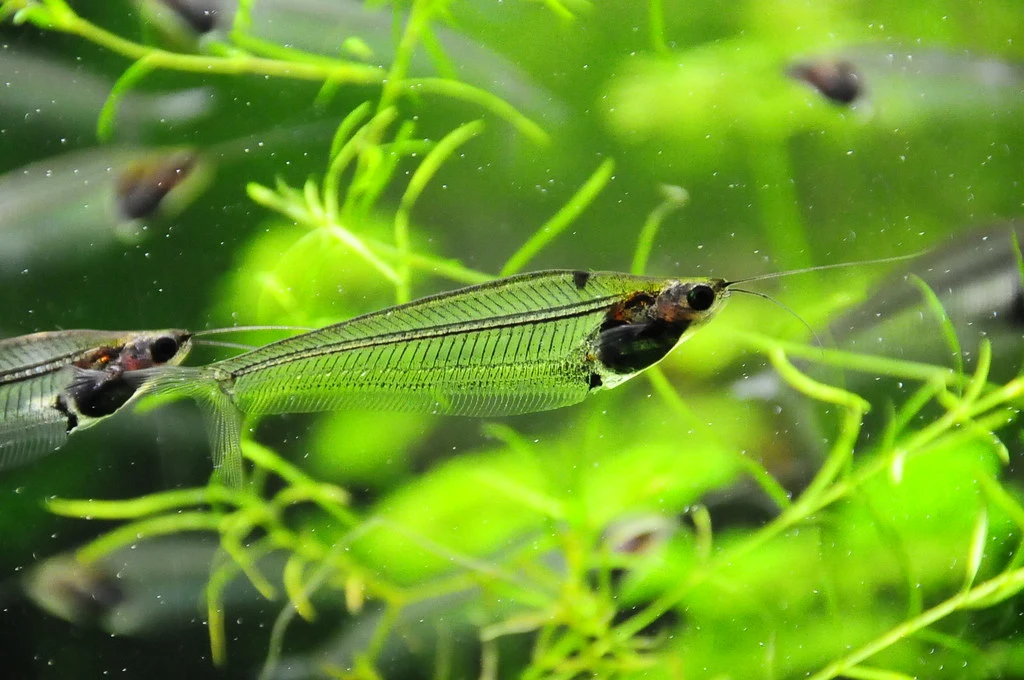
As the name suggests, the Glass Catfish has a transparent body. This see-through body allows its inner organs to be visible. This fish grows up to 4 to 6 inches in length. In addition to their glassy look, their fins are almost invisible, completing the ghostly look.
Unlike other fish with whiskers, the Glass Catfish has long, slender whiskers. These whiskers are used for detecting food and navigation. Additionally, these barbels are equipped with taste buds so the fish can take a sample
Sturgeon
The Sturgeon inhabits both freshwater and coastal marine environments of the Northern Hemisphere. This fish is believed to have existed since 200 million years ago, the time of the dinosaurs. Due to its resilience and adaptability, this old soul is widespread across the north.
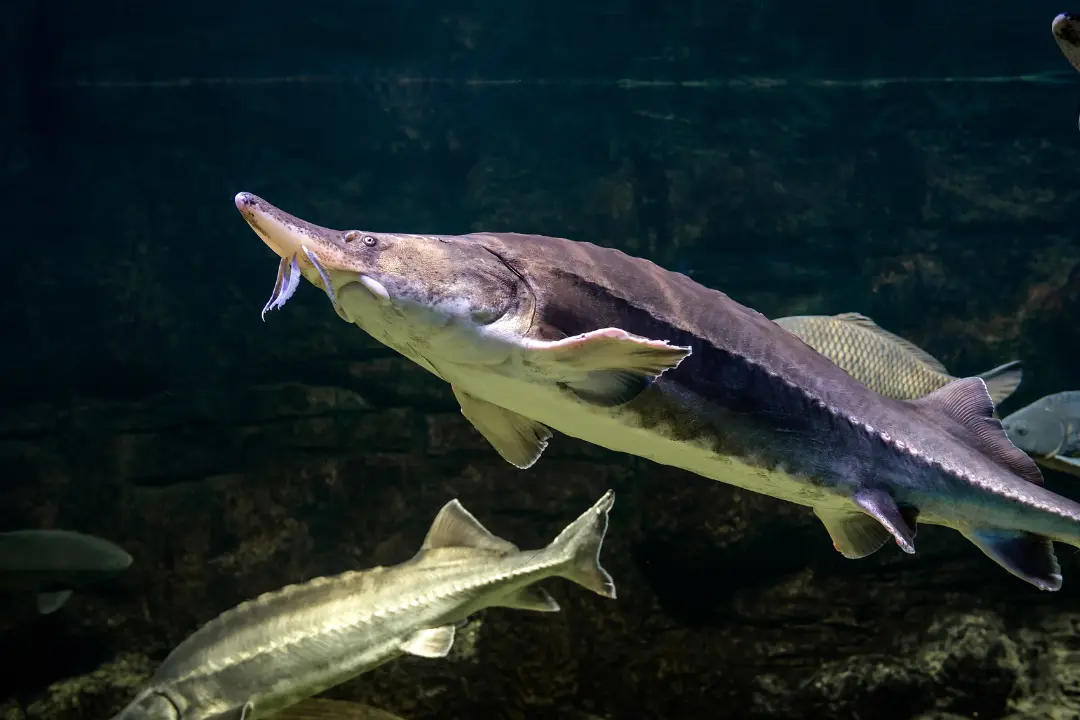
Sturgeons have a long armored body reaching up to 18 feet. This fish has a prehistoric look as its body is covered with scutes, rather than scales. They have an olive-grayish body that helps them blend in the seabed.
This fish with whiskers has captivating adaptations, like its shark-like tail and barbels. It uses these barbels to detect food in murky and low-light waters. These barbels are actually sensory organs that can taste stuff as well. Primarily feeding on small crustaceans and invertebrates, this fish can scavenge for food even in the darkest depths of its habitat.
Hagfish
Hagfish has been around since 300 million years ago. This makes it one of the oldest living vertebrates on planet Earth. It primarily inhabits deep and cold waters of the sea. This bewitched scavenger sometimes burrows inside dead creatures and eats them inside out. Quite fitting for something called a hag, don’t you think?

In appearance, the hagfish has a long slimy body that lacks any scales, like an eel. It can grow up to 40 inches in length, with colors ranging from pink to purple.
Unlike other fish, the Hagfish has no jaw. Its head is made out of cartilage. Moreover, its body is very flexible. Sometimes, this creature ties itself in a knot to clean the excessive slime or to subdue prey.
Additionally, the hagfish has moustache-like barbels near its mouth. These are sensory organs equipped with tastebuds that allow the fish to taste stuff. They also help in navigation as the fish lives in the dark depths of the sea. All in all, this fish with whiskers lives up to its name.
Electric Catfish
The Electric Catfish originates from the Nile River and other freshwater bodies of Africa. This vibrant fish inhabits slow-moving rivers and lakes. This fish has a reputation for generating electric shocks for hunting and self-defense.
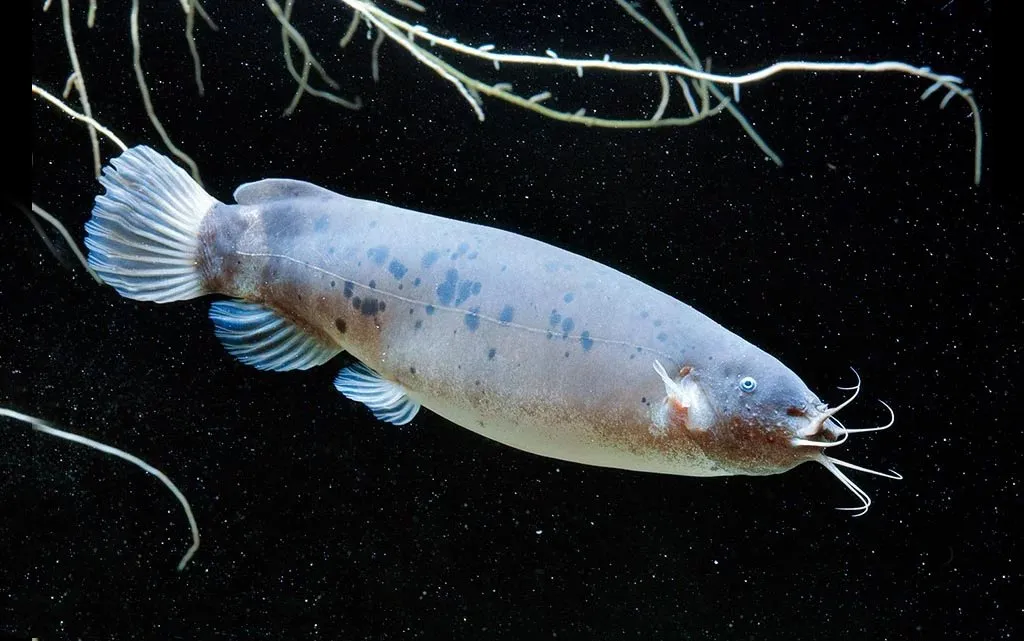
The Electric Catfish boasts a cylindrical and scaleless body with a brown or grey color. Moroever, Its body can reach up to 1 meter in length. This strategic build is covered with a slimy substance that aids in movement.
Unlike many other fish with whiskers, the Electric Catfish has small barbels. These barbels are used for their sensory capabilities. The mouth and the small barbels work together to detect food in the substrate. These adaptations are crucial for this fish’s survival as it consumes small fish, crustaceans, and invertebrates from the substrate.
Banjo Catfish
The Banjo Catfish belongs to the slow-moving rivers and streams of the Amazon basin. Its natural habitat has a soft substrate with a lot of leaf litter. This environment provides many hiding spots. Thus, it is perfect for the nocturnal fish, as it rests during the day and becomes active at night.

The Banjo Catfish has a flattened body like a banjo, hence the name. This fish has a brownish or mottled color that allows it to blend in the riverbed. An adult Banjo Catfish can grow up to 6 inches in length. Additionally, it has a broad head and a tapered tail. In essence, these adaptations allow the fish to hide from predators and survive the wild.
The Banjo Catfish has sensory whiskers located near its mouth. These barbels are very sensitive to chemical and tactile stimuli. They help the fish detect food in dark environments with low visibility. The whiskers scan for small invertebrates and crustaceans as the Catfish scavenges the substrate. All in all, these adaptations are crucial for Banjo’s nocturnal lifestyle.
Koi
The Koi fish hails from Japan. This fish is selectively bred from the common carp for its bright colors and ornamental look. This fish thrives on slow-moving ponds and streams. It also has a cultural significance related to peace and prosperity in many parts of Asia.
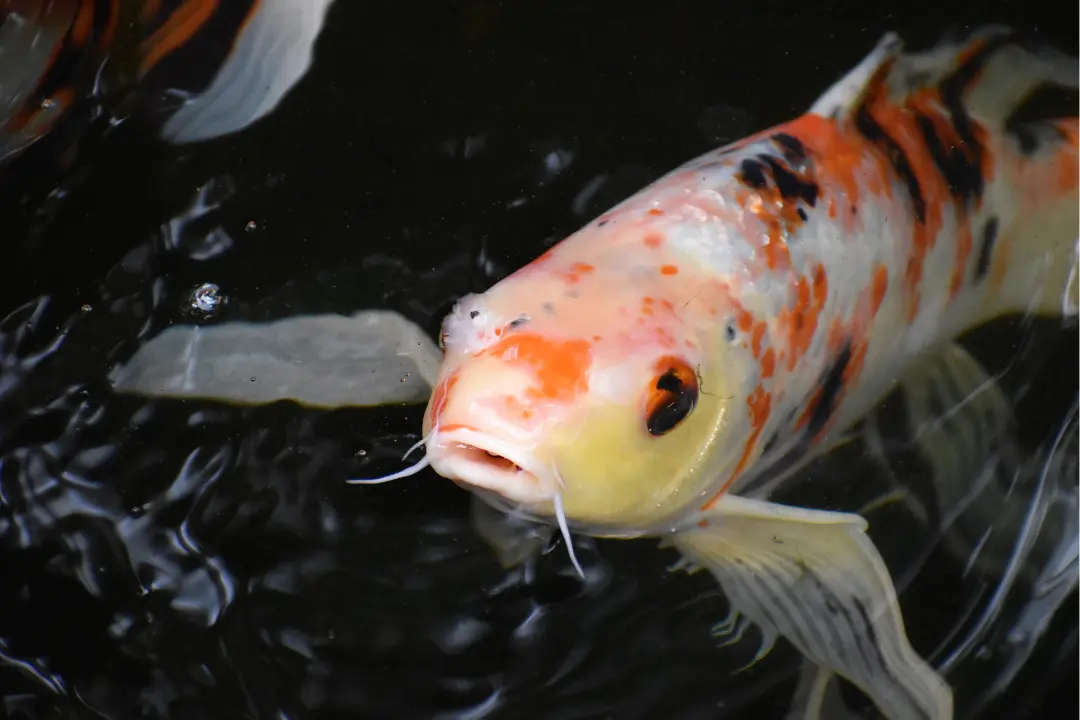
The Koi fish is well known for their appearance. It comes in a variety of colors like white, black, red, yellow, blue, and cream. Additionally, their bodies are adorned with patterns and scales that elevate their beauty. Some popular varieties include the Kohaku, Sanke, and Showa. This fish has a large body that can grow up to 3 feet in length.
Another distinctive feature includes the Koi fish barbels. These barbels are sensory organs located near the mouth. They help the fish navigate and find food in murky waters. These sensory barbels have taste buds that help the Koi fish taste food before eating it.
Iridescent Shark
The iridescent shark inhabits the Mekong River basin in Southeast Asia. It thrives in rivers, ponds, swamps, and flooded fields, particularly during the rainy season. This fish has been introduced to many freshwater bodies of the world due to its popularity in the fish trade.
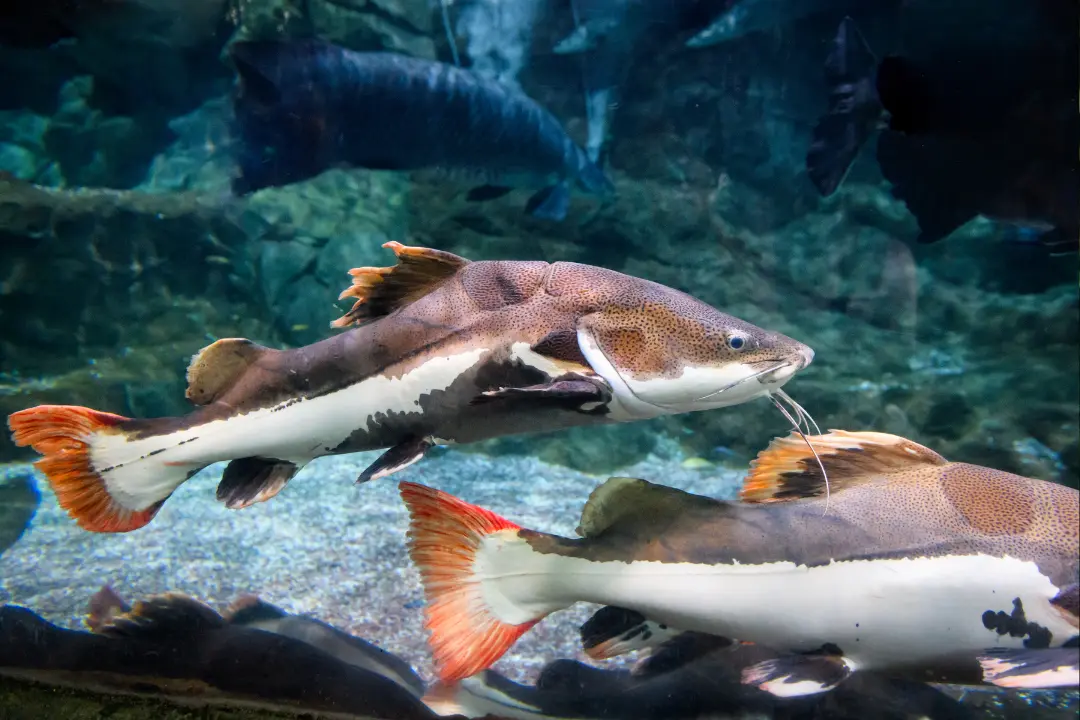
The iridescent sharks are easily recognizable as they have bodies spanning up to 4 feet. Their torpedo-shaped bodies have silver or dark grey color. Additionally, their bodies boast a beautiful sheen that reflects lights. Young individuals are more colored however, the colors fade away as the fish matures.
Another adaptation includes the whiskers. These whiskers are located near the mouth and help the fish navigate and locate food.
Dojo Loach
The Dojo Loach or Pond Loach originates from slow-moving rivers, ponds, and rice paddies. It is generally found in countries like China, Japan, and Korea. This fish adapts well to many habitats and adds to the overall biodiversity.
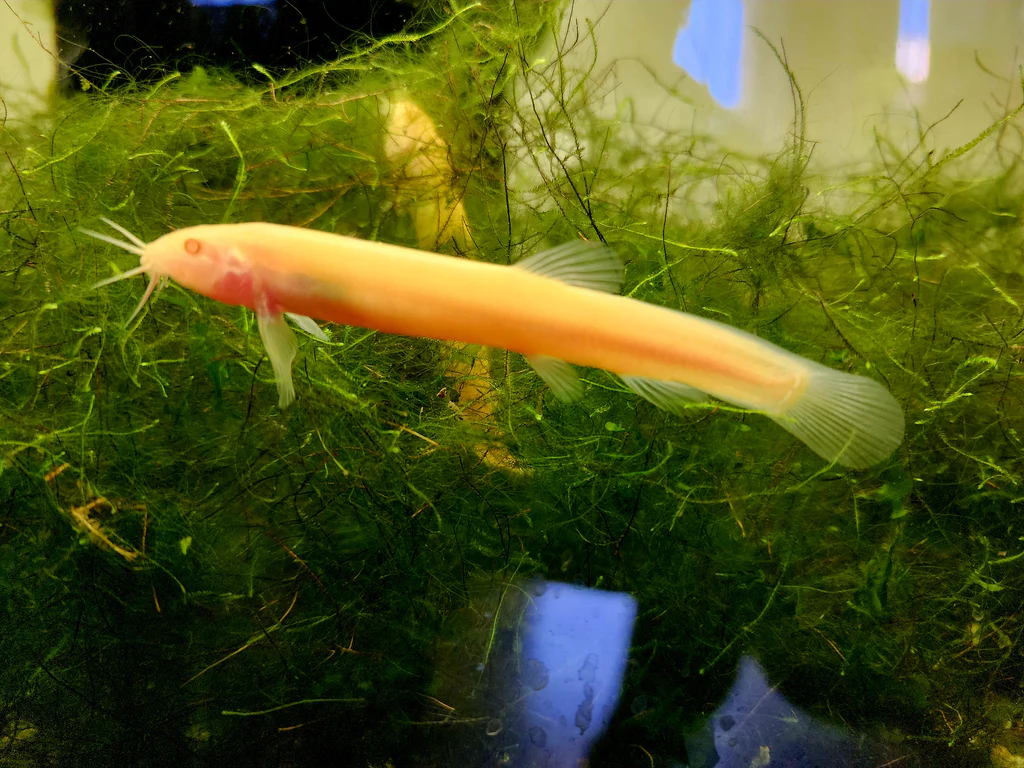
The Dojo Loach boasts a long, eel-like body that can grow up to 12 inches in length. Its skin is covered in slimy mucous that aids in movement. It has murky dark colors like olive-green or brown that allow it to blend in the riverbed. However, its underbelly is a little lighter.
Dojo loach has sensory barbels located near its mouth. These organs are highly sensitive to touch and taste, allowing the fish to scavenge the substrate and navigate in low light.
Carp
Carp fish is found in many freshwater habitats across Asia and parts of Europe. It thrives in slow-moving rivers, lakes, and ponds with vegetated bottoms. Interestingly, this fish is tolerant to a variety of water conditions, hence it is one of the most widespread fish globally. This fish is even selectively bred, thanks to its beautiful ornamental look.
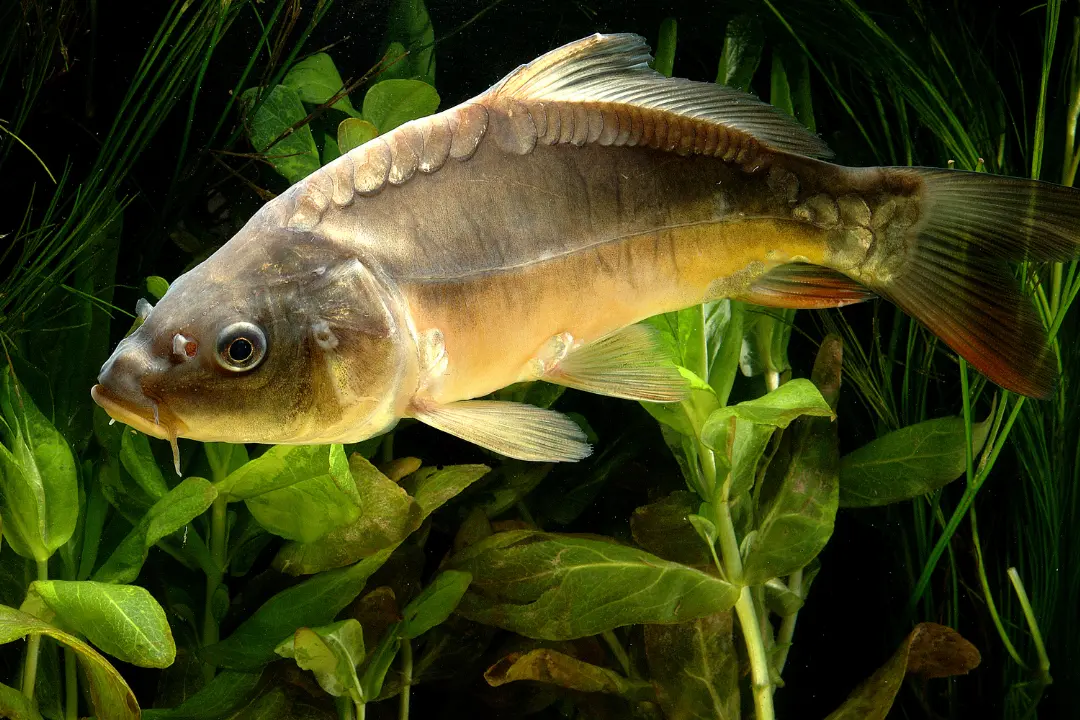
The Carp has a robust body and a broad, flat head. Additionally, it has large and powerful fins that aid in swimming. It has a range of colors including shades of green, brown, and gold. This fish can grow up to 3 feet and weigh 30 pounds, so it’s best for ponds and large tanks.
Carp have whisker-like appendages near their mouth. These barbels not only elevate their overall dragon-like look but also add functionality. These barbels are used for navigation and foraging food in murky water. They are equipped with taste buds and sensory receptors to detect tactile movement.
Redtail Catfish
The Redtail Catfish is native to the freshwaters of the Amazon and Orinoco river basins. It thrives in warm and slow-moving tropical waters. This freshwater giant has a beautiful appearance and great adaptability.

Redtail Catfish have a striking dark body with contrasting red-orange tails. Its body is adorned with beautiful black, grey, and white, patterns. These patterns not only elevate its looks but also provide camouflage. Usually, adult Redtail Catfish have a subdued color compared to young ones. In terms of size, this fish with whiskers can reach up to 4 feet, making it well-suited for large tanks.
Whiskers are one of the most notable features of the Redtail Catfish. These barbels are equipped with taste buds and sensory nerves. These sensitive receptors work together to help the fish navigate and find food in low-light, murky waters.
Goatfish
Goatfish are primarily found in tropical and subtropical waters. This fish thrives in coral reefs and sandy or muddy bottoms near shorelines. It can adapt well to shallow or deep waters.
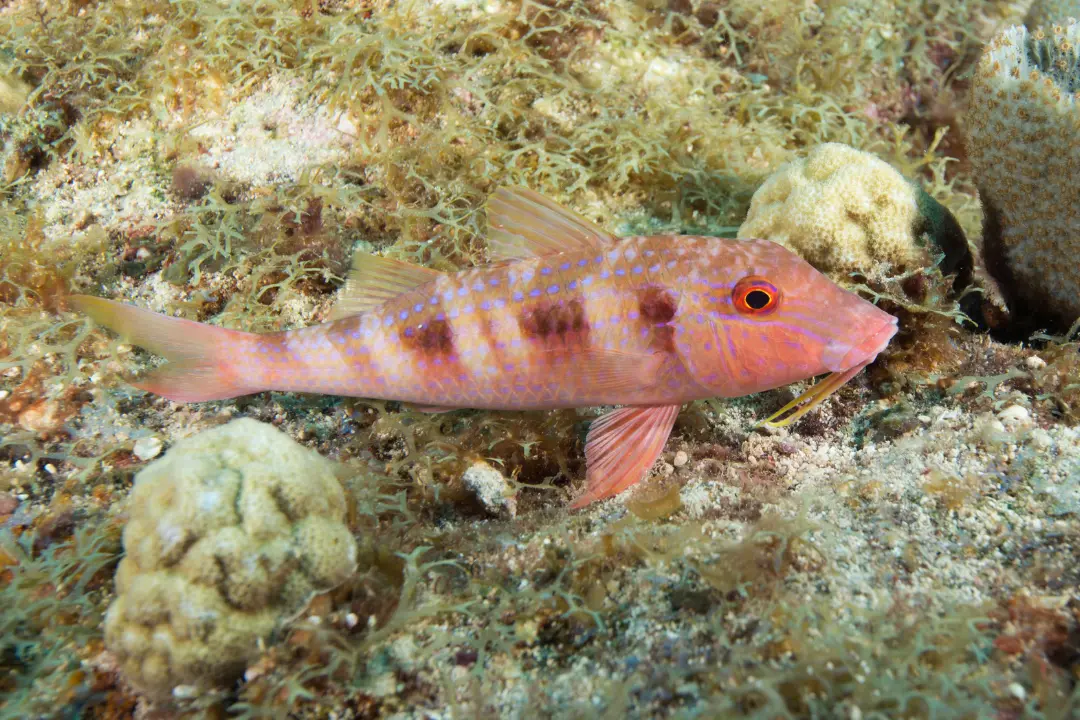
Goatfish have an elongated body and unique coloration. Their bodies display vibrant colors like red, yellow, or blue. Sometimes their bodies are adorned with striking patterns that complete the look.
Most of these fish grow up to 10-14 inches in length however, some even reach a maximum of 24 inches. All these features combined, make a strategic fish with beauty and functionality.
The goatfish has intriguing appendages near its mouth. Unlike other fish with whiskers, the goatfish have special barbels with chemosensory cells. These cells allow the fish to detect prey hidden under the substrate. Also, these barbels are important for navigation in dark waters.
Zebrafish
Zebrafish inhabit the freshwater streams and rivers of India and Bangladesh. It thrives in slow-moving or standing waters like rice paddies and ponds. This fish is well known for its hardiness and adaptability, thus popular in the fish trade.
Zebrafish have a small body reaching about 2.5 to 4 inches in length. Their body is adorned with beautiful horizontal blue and silver stripes. They have streamlined bodies with small fins that work together to make them an agile swimmer.
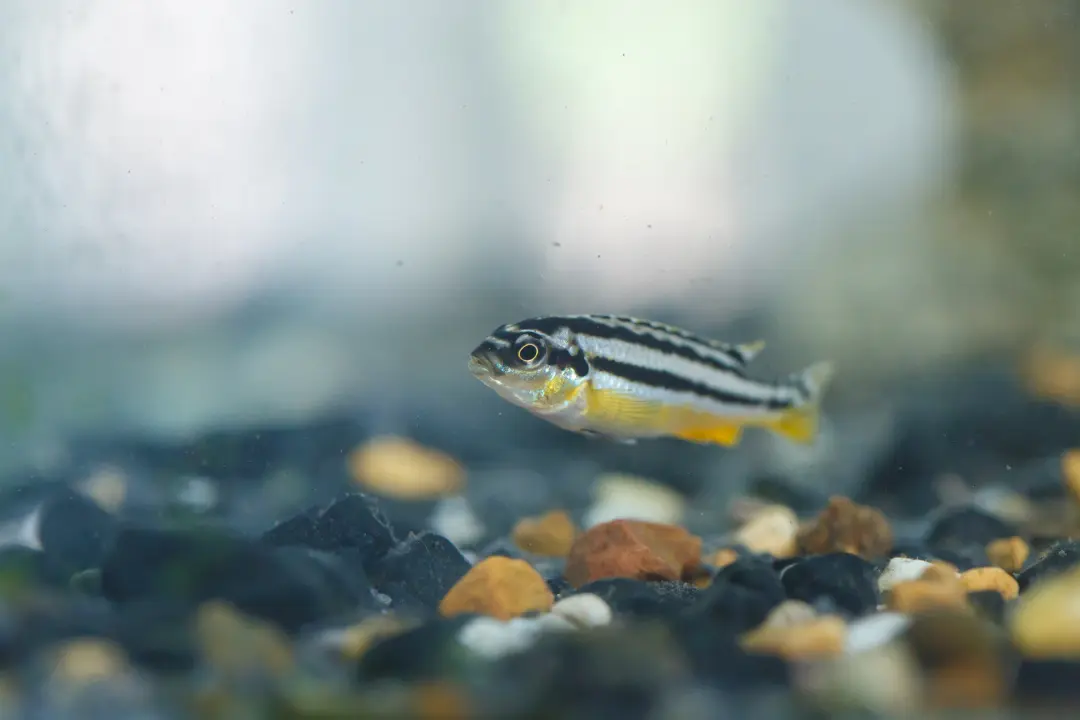
Interestingly, this fish has a see-through body at the early stages of development. As the fish matures, its colors gradually darken. An adult Zebrafish can have a variety of other colors, including yellow, gold, and shades of red
The zebra-like fish has sensory barbels located near its mouth. These barbels are not very prominent compared to other fish with whiskers as they are really small. However, they play a crucial role in the fish’s survival. These barbels are equipped with sensory receptors and taste buds. These specialized organs allow the fish to navigate and find food in low light.
Pictus Catfish
The Pictus Catfish belongs to the warm, freshwater of the Amazon and Orinoco basins. These habitats provide the fish with plenty of shelter and food sources.
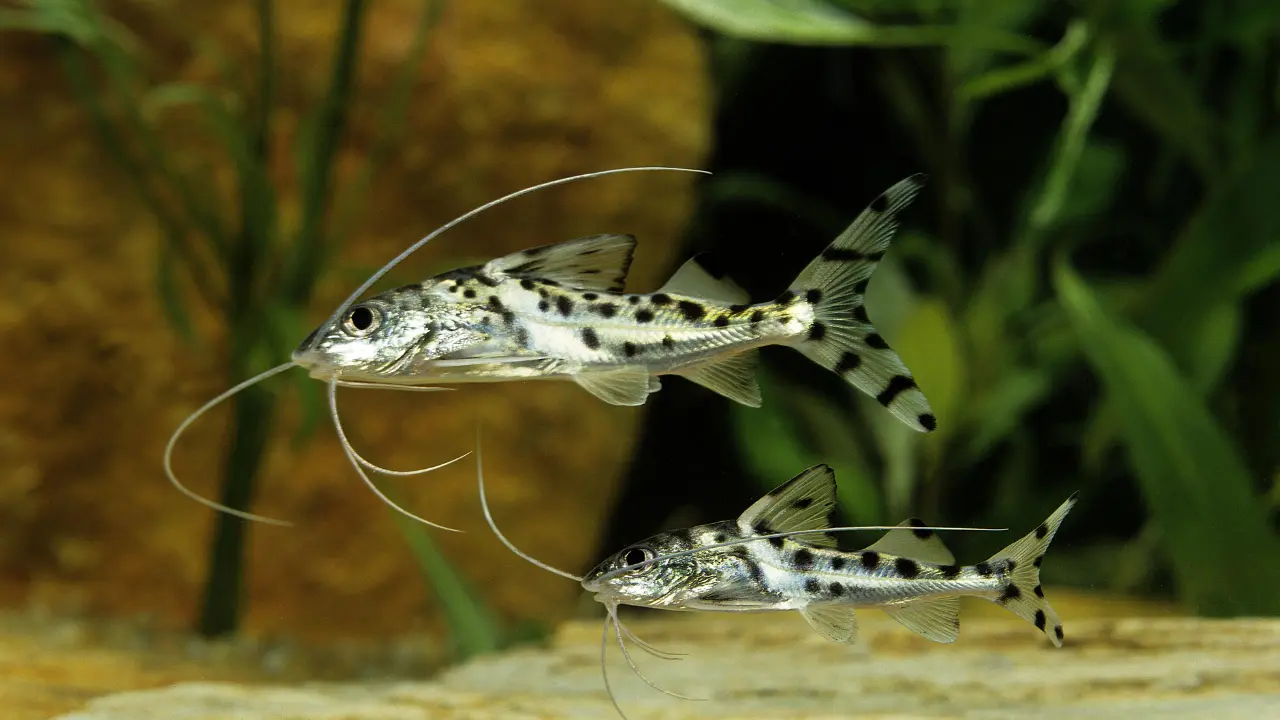
Pictus Catfish has a sleek, silver body, adorned with beautiful black spots. This fish typically grows up to 5-6 inches in length. In addition, its streamlined body is equipped with long flowy fins that aid the fish to swim.
Interestingly, this fish has a predatory nature however, it is very peaceful. This fish with whiskers can even coexist with a variety of tankmates
A standout feature of the Pictus catfish is its beautiful barbels. It has long sensory appendages that not only add to the looks but also help the fish survive. These barbels have sensory nerves and tastebuds that help the fish navigate and find food in its diverse habitat. They also have a built-in mechanism to sense chemical changes in the water. This way the fish can track and hunt prey.
Bagrid Catfish
The Bagrid Catfish originates from the freshwaters of Africa and Asia. It mainly inhabits water bodies like rivers and lakes. This fish has great adaptability as it thrives in slow-moving and fast-flowing waters. It can tolerate a range of water conditions thus, found in many places across the globe.

The Bagrid Catfish has an elongated body with no scales. They have a wide variety of colors but mainly include brown or grey hues. They can often have spots or stripes but it is not common.
This fish has a range of sizes, from several inches to several feet. Primarily carnivorous, this fish has a large mouth that aids in hunting smaller fish and invertebrates.
The Bagrid Catfish have sensory barbels that extend from their mouth. These barbels have special receptors to detect prey. Moreover, they also help the fish navigate in dark and murky waters. These extensions are crucial for the catfish’s survival as it has poor eyesight.
More Fish with Whiskers
Here is a list of more fish with Whiskers. To find out more about these amazing aquatic creatures, keep up with our articles and explore the amazing underwater world.
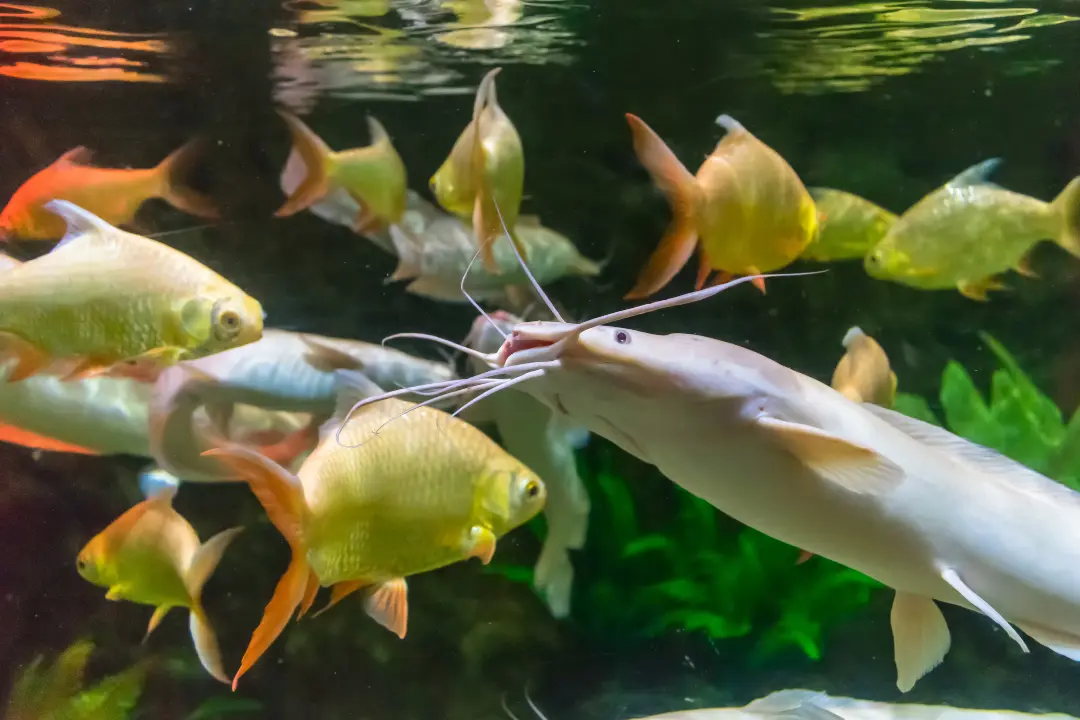
- Channel Catfish
- Flathead Catfish
- Blue Catfish
- Walking Catfish
- Lace Catfish
- Brown Bullhead
- Granulated Catfish
- Tiger Catfish
- White Catfish
- Asian Redtail Catfish
- Iridescent Shark
- Striped Raphael Catfish
FAQ’s
Can you keep catfish in a home aquarium?
Yes! You can keep a catfish in a home aquarium however, it can be pretty demanding. You must consider the tank size, water quality, tankmates, and many other factors. It’s best to do some research and then decide if you want to add a catfish to your tank or not.
What is the name of the fish with whiskers?
Many fish have whiskers! But these are actually called barbels. Some fish with barbels include Pictus Catfish, Koi, and sturgeon.
What tropical fish has long whiskers?
Pictus Catfish is a tropical fish that has long whiskers. Its whiskers are actually used for navigation and foraging food.
What is the name of the fish with a mustache?
Fish don’t actually have a mustache! It is an extension of their mouth called barbels. These extensions aid the fish in finding food and navigating in low-light waters. Some fish with a so-called mustache include Mustache Catfish and Bristlenose Pleco.
Why do some fish have mustaches?
Some fish have specialized extensions located near their mouth that look like a mustache. However, these extensions are called barbels. These extensions have sensory receptors that help the fish scavenge food from the substrate and navigate in low-visibility waters.
Conclusion
In conclusion, this was all about the 15 most popular fish with whiskers. In today’s article, we have discussed their origin, natural habitat, and appearance. In addition, we also explored their whisker-like adaptations along with their purpose.
All in all, fish with whiskers generally use these extensions to navigate and forage food from the substrate. Most importantly, they have scavenging behavior and usually inhabit low-light areas. Hence these whiskers are not just for looks but necessary for survival. In some cases, these barbels also elevate the fish’s appearance.
Lastly, I would like to ask you, what do you think about the whiskers? let us know your thoughts in the comments below!

